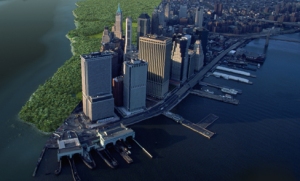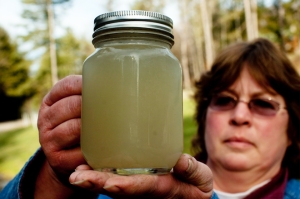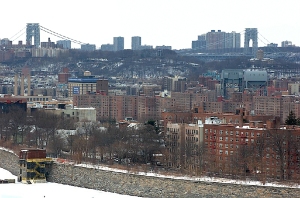New York City used to have a rich environmental history. Before the Dutch started claiming land away from the Native American tribes that had been inhabiting there for thousands of years, the island of Manhattan (or Mannahatta as it was called by the native tribes) was like a green emerald between the two rivers. It’s interesting for our modern mentalities to learn that the greatest metropolis of today used to be a giant pine forest, with streams running all through the island and marshlands making up most of the downtown area. Teaming with wildlife, like bears, otters, elk, and beavers, the island would have been akin to the greatest of today’s national parks. It’s sort of weird to think that today we need to designate land in special parks for naturally occurring ecological and wildlife activity to still flourish.
To remind us of the natural ecology and landscape that we so easily forget among the hustle and bustle of modern life, the Wildlife Conservation Society has constructed a cool interactive map called the Mannahatta Project that shows what NYC would have looked like in 1609. Here’s an interesting video explaining the project a little further. Not only is it a testament to our human ingenuity and ability to transform entire islands and landscapes to suit our needs and wants, it’s really interesting to know that under your apartment building was once a stream, or a bear habitat, or even all water. The geological extent of the island of Manhattan is naturally 30% smaller, because the majority of the waterfront (mostly downtown) is completely man-made. The natural history of the city is definitely a fascinating field, and it makes you question the direction we’re going in.
But what’s good about realizing that we have this immense potential to change the face of a landscape is the reverse. That also means we have the potential to change things for the better. In 2007 Mayor Bloomberg announced his PlaNYC idea, “a bold environmental agenda for the city of New York, to make the city a greener place.” PlaNYC calls for improvements that are necessary to meet the needs of our growing population; as well as revamping our aging infrastructure, especially transportation, and assess new needs from the changing climate and evolving economy. It’s a loaded task that looks bring together 25 city agencies to minimize the carbon impacts of existing and future developments while maximizing clean air and water for everyone. NYC ranks 17 out of 25 on a scale of air quality, so a number of traffic congestion initiatives have been implemented to help (such as an increased bridge toll, hybrid fuel buses, and new green bike paths to cut down on the number of cars in the city). However, it’s not the loads of vehicles that cause NYC’s poor air quality but rather the fuel that heats the buildings, and so initiatives have been set to reduce and convert the need for buildings to run on crude, dirty fuel oils, to more purified and less-pollutive fuel methods. Along with it’s overall agenda to become the greenest city in the nation, PlaNYC aims to completely phase out these crude, dirty oils by 2030. It’s a necessary step that can open up further incentives to develop lesser emitting fuels. NYC is making great strides in keeping its title as the biggest walking city, with over half of its population not owning a car and the development of green ways and enlarging of pedestrian paths. After all, everyone in the city is a pedestrian most of the time. Through revitalizing infrastructural changes and new policies, the plan ultimately seeks to improve the quality life of all the city’s organisms.
A more current issue is the impact of what potential hydrofracking could have on the city’s main water supply. Fracturing the shale rock to get to the natural gas in the Marcellus shale under the watershed that directly supplies NYC with it’s famously pristine, high-quality drinking water would create a scenario similar to a Chris Nolan movie plot. It involves pumping water, sand, and highly toxic chemicals down into the shale rock to loosen up the rock and actually fracture it to release the natural gas. These chemicals and gas would then leach into the ground water and reduce our naturally pure water supply to something like a used bathtub. We are blessed to have such a well-functioning infrastructural extraction from the natural ecosystem service that is the southward flowing water from the Delaware-Catskill water system, and an interesting article in the New York Observer outlined Governor Cuomo’s plan to keep it clean. It turns out that most pollution control equipment is not only capital-intensive, but also expensive to operate and maintain. The good thing about the use of natural systems as pollution control devices is that they tend to be cheaper to build and much cheaper to maintain.It would cost $8 billion to build the new facilities to treat the water that New Yorkers get every day, whereas we spend $200 million a year to protect and maintain the natural ecosystems that allow for the watershed to be so naturally clean. The idea of stewardship of the very ecosystems that maintain our wellbeing is central to the safety of our future, unless we start fracking, then we’d be up the creek without a paddle.
Named after Jonas Bronck, who first purchased 500 acres of it from the native tribes, the current infrastructural disaster that is the Bronx is witnessing new innovations taken by groups to restore the ecology of much of what’s left of its green space and natural landscapes. No longer is it the green pastoral country side that inspired writers and poets like Edgar Allen Poe and Joseph Rodman Drake. Over the past 200 years the River’s course has been altered dramatically by human impact and industry. During the era of Robert Moses, the Bronx fell into a period of urban decay. The quality of life, particularly in the South Bronx decreased dramatically. Neighborhoods were fragmented by the construction of numerous highways. In particular, the construction of the Sheridan and Cross-Bronx Expressways further distanced the Bronx River communities from each other and from the River itself. The Bronx River Alliance is working to restore the Bronx River by reducing erosion, bank stabilization, and invasive plant removal. What it’s doing is essentially rebuilding the river to make it inhabitable again. This is aided by georeferencing, or using old maps to show what the landscape used to look like and then layering topography, water systems, and then biology over each other to recreate the naturally occurring landscape. Once life has a foothold in the environment again, then the real healing to the landscape can begin; as biodiversity is the key to any healthy ecosystem. An example of this is building up the shellfish population of the river, because shellfish like oysters and clams are essential to biofiltering the river water, and thus a healthier environment for all the life in the ecosystem. And when the ecosystem is healthier, the wildlife aren’t the only ones who benefit, but the community of people around it benefit as well.
Now what is Fordham doing to create a more green landscape? On their website, Fordham says it “is committed to sustainability as a central consideration in all aspects of its activities including its curriculum, student development and education, faculty and staff involvement, and physical plant operations.” With its main campus located in the Bronx, the university claims it ”will endeavor to design, construct and maintain its buildings, infrastructure and grounds in a manner that ensures environmental sustainability. Reaching beyond compliance in areas of environmental concern, Fordham will pursue sustainability best practices in a broad range of areas…” Given the set up of the university, it does have a pretty green infrastructure. The ram van service that transports students from the Rose Hill and Lincoln Center campuses reduces the students’ need to take other methods of transportation, and each van can hold about 14 people maximum. 23% of the vehicles in Fordham’s fleet are electric. Fordham did sign on to mayor Bloomberg’s PlaNYC in an effort to reduce greenhouse gas emissions 30% by the year 2017; and since signing on, the university has reduced its overall emissions by 23% since 2005. Another great accomplishment by the university is that all new construction must reach LEED Silver requirements, with two that meet silver standards already and three that meet LEED-EB standards. The new building being constructed at the Lincoln Center campus will also be LEED Silver certified. Fordham diverts 90 percent of construction and demolition waste from landfills. To conserve water, the university has installed dual-flush toilets, efficient laundry machines, low-flow faucets and showerheads, waterless urinals, and weather-informed irrigation systems. So then why was Fordham given a C+ on its College Sustainability Report Card?
It seems that the weakest grades were given to the shareholder engagement and endowment transparency. The shareholder engagement category examines how colleges conduct shareholder proxy voting. As investors, colleges have an opportunity to actively consider and vote on climate change and other sustainability-related shareholder resolutions. Forming a shareholder responsibility committee to advise the trustees allows schools to include students, faculty, and alumni in research and discussion of important corporate policies on sustainability. What I suppose would be a good way to increase our ratings in this category is to continue our work with the St. Rose’s Garden to promote healthy environmental practices and urban ecology, and publicize the progress to the greater faculty, student, and alumni, and neighborhood communities. The bourgeoning field of urban ecology in our city-strewn modern world could use some more national attention as we realize that cities aren’t just the dwellings of people, nor should they be. All New Yorkers are familiar with sharing the subways with our infamous rats, and every now and then the Central Park hawks make the news. At Fordham, our black squirrels have just as much chutzpah as the city pigeons, stubbornly refusing to move until death by sneaker is assuredly right over their heads. We know that biodiversity is one of the three main components of a well-functioning ecosystem, so what is to be said about a geographic area of land that is paved and primarily inhabited by homo sapiens?
The endowment transparency category evaluates the extent to which schools release information about their endowment investment holdings and shareholder proxy voting records. Access to endowment information is useful within a college community to foster dialogue about opportunities for investing in clean energy, and about using proxy votes to encourage responsible corporate practices. A week after Sandy hit, environmental mogul Bill McKibben and his organization, 350.org, have launched a nationwide program to have pension funds and university endowments divest themselves from fossil fuel stocks. I suggest we do as the experts do – that the university not only, obviously, provide better access to their endowment investments, but also offer more possibilities for green investment. With all the money we pay for this school, we have a right to know where all of it is going. A louder student and faculty voice can move the university to practice more green approaches to college life and community fostering.





